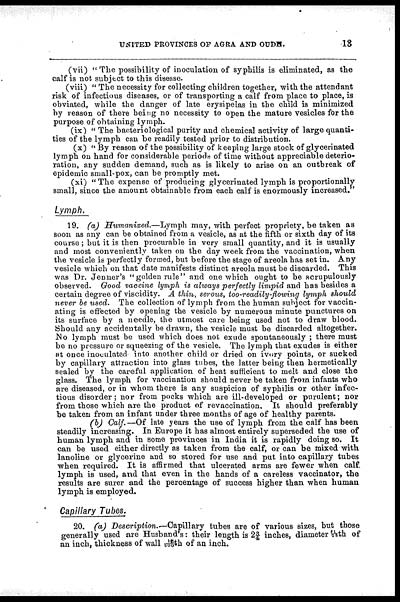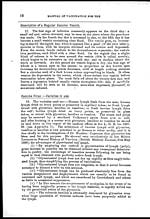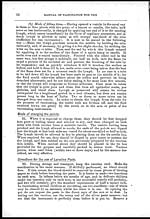Medicine - Vaccination > 1903 - Manual of vaccination for the United Provinces of Agra and Oudh > Manual of vaccination for the United Provinces of Agra and Oudh
(25) Page 13
Download files
Individual page:
Thumbnail gallery: Grid view | List view

UNITED PROVINCES OF AGRA AND OUDH. 13
(vii) "The possibility of inoculation of syphilis is eliminated, as the
calf is not subject to this disease.
(viii) " The necessity for collecting children together, with the attendant
risk of infectious diseases, or of transporting a calf from place to place, is
obviated, while the danger of late erysipelas in the child is minimized
by reason of there being no necessity to open the mature vesicles for the
purpose of obtaining lymph.
(ix) " The bacteriological purity and chemical activity of large quanti-
ties of the lymph can be readily tested prior to distribution.
(x) " By reason of the possibility of keeping large stock of glycerinated
lymph on hand for considerable periods of time without appreciable deterio-
ration, any sudden demand, such as is likely to arise on an outbreak of
epidemic small-pox, can be promptly met.
(xi) "The expense of producing glycerinated lymph is proportionally
small, since the amount obtainable from each calf is enormously increased."
Lymph.
19. (a) Humanized.—Lymph may, with perfect propriety, be taken as
soon as any can be obtained from a vesicle, as at the fifth or sixth day of its
course ; but it is then procurable in very small quantity, and it is usually
and most conveniently taken on the day week from the vaccination, when
the vesicle is perfectly formed, but before the stage of areola has set in. Any
vesicle which on that date manifests distinct areola must be discarded. This
was Dr. Jenner's "golden rule" and one which ought to be scrupulously
observed. Good vaccine lymph is always perfectly limpid and has besides a
certain degree of viscidity. A thin, serous, too-readily-flowing lymph should
never be used. The collection of lymph from the human subject for vaccin-
ating is effected by opening the vesicle by numerous minute punctures on
its surface by a needle, the utmost care being used not to draw blood.
Should any accidentally be drawn, the vesicle must be discarded altogether.
No lymph must be used which does not exude spontaneously ; there must
be no pressure or squeezing of the vesicle. The lymph that exudes is either
at once inoculated into another child or dried on ivory points, or sucked
by capillary attraction into glass tubes, the latter being then hermetically
sealed by the careful application of heat sufficient to melt and close the
glass. The lymph for vaccination should never be taken from infants who
are diseased, or in whom there is any suspicion of syphilis or other infec-
tious disorder; nor from pocks which are ill-developed or purulent; nor
from those which are the product of revaccination. It should preferably
be taken from an infant under three months of age of healthy parents.
(b) Calf.—Of late years the use of lymph from the calf has been
steadily increasing. In Europe it has almost entirely superseded the use of
human lymph and in some provinces in India it is rapidly doing so. It
can be used either directly as taken from the calf, or can be mixed with
lanoline or glycerine and so stored for use and put into capillary tubes
when required. It is affirmed that ulcerated arms are fewer when calf
lymph is used, and that even in the hands of a careless vaccinator, the
results are surer and the percentage of success higher than when human
lymph is employed.
Capillary Tubes.
20. (a) Description.—Capillary tubes are of various sizes, but those
generally used are Husband's: their length is 2¾ inches, diameter 11/5th of
an inch, thickness of wall 15/700th of an inch.
Set display mode to: Large image | Zoom image | Transcription
Images and transcriptions on this page, including medium image downloads, may be used under the Creative Commons Attribution 4.0 International Licence unless otherwise stated. ![]()
| India Papers > Medicine - Vaccination > Manual of vaccination for the United Provinces of Agra and Oudh > Manual of vaccination for the United Provinces of Agra and Oudh > (25) Page 13 |
|---|
| Permanent URL | https://digital.nls.uk/90721510 |
|---|




